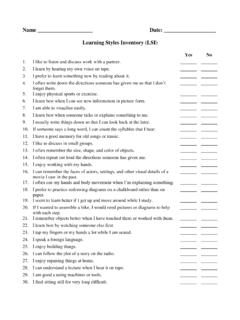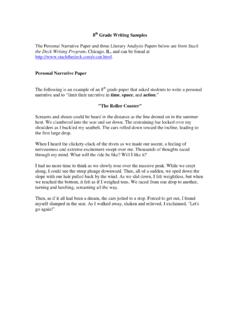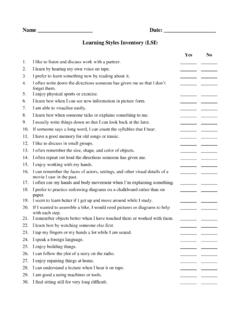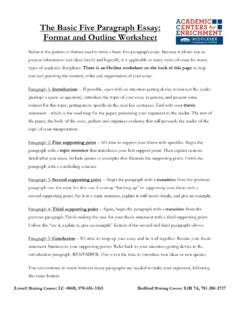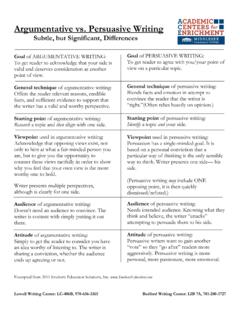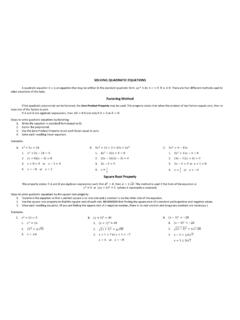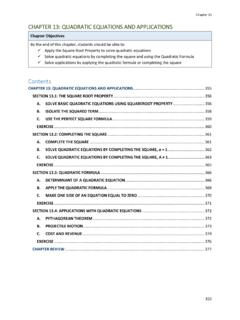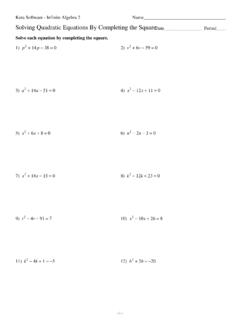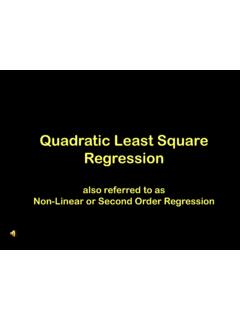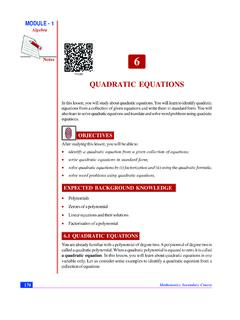Transcription of MAT 080-Algebra II Applications of Quadratic Equations
1 MAT 080-Algebra II. Applications of Quadratic Equations Objectives a Applications involving rectangles b Applications involving right triangles a Applications involving rectangles One of the common Applications of Quadratic Equations is to find the unknown length and width of a rectangle. To solve these types of problems, we need to use the formula for the area of a rectangle: length width = area or l w A. This is a formula that is frequently used, and you will need to memorize it. Example 1. A rectangle has a length that is 4 meters more than the width. The area of the rectangle is 117 square meters. Find the dimensions of the rectangle. Step 1 Draw a diagram of the rectangle. Label the length and the width.
2 Since we know nothing at all about the width, we will call it x. In the problem we are told that the length is 4 meters more than the width, so we will let 4 x represent the length. length 4 x Area = 117 sq. meters width = x 2 MAT 080: Applications of Quadratic Equations Step 2 Write the equation using the formula for the area of a rectangle and the information from the diagram. Formula: length width area or l w A. From diagram: width x, length 4 x, and area 117 sq. meters length width area Formula (4 x) x 117 Substitute (4 x) for length, x for width, and 117 for area. 4x x 2 117 Distribute x through (4 x). x2 4 x 117 117 117 Write the equation in standard form by subtracting 117 from x2 4 x 117 0 both sides.
3 ( x 13)( x 9) 0 Factor Take each factor, set it equal to 0, and solve the resulting Equations : x 13 0 x 9 0. x 13 13 0 13 x 9 9 0 9. x 13 x 9. Since length must be positive, the solution that fits the problem is x 9. We discard the x 13. Step 3 Substitute 9 in for x in the diagram in order to determine the dimensions of the rectangle. length 4 x length 4 9 13. width = x width = 9. So, the width is 9 meters, and the length is 13 meters. Applications Involving Rectangles 3. Practice Problem 1. A rectangle whose area is 112 square feet has a length that is 6 feet greater than the width. Find the dimensions of the rectangle. Solution to this Practice Problem may be found on page 12. Example 2. A rectangle has a width that is 5 feet less than the length.
4 The area of the rectangle is 126 square feet. Find the dimensions of the rectangle. Step 1 Draw a diagram of the rectangle. Label the length and the width. Since we know nothing at all about the length, we will call it x. In the problem we are told that the width is 5 feet less than the length, so we will let x 5 represent the width. (Note that 5 x is not correct!). length x Area = 126 sq. feet width = x 5. Step 2 Write the equation using the formula for the area of a rectangle and the information from the diagram. Formula: length width area or l w A. From diagram: length x, width x 5, and area 126 sq. feet length width area Formula x( x 5) 126 Substitute x for length, x 5 for width, and 126 for area.
5 Example 2 continues on next page 4 MAT 080: Applications of Quadratic Equations Example 2-continued x( x 5) 126 Equation from last step on previous page x 2 5 x 126 Distribute x through (x 5). x 2 5 x 126 126 126 Write the equation in standard form by subtracting 126 from x 2 5 x 126 0 both sides. ( x 14)( x 9) 0 Factor Take each factor, set it equal to 0, and solve the resulting Equations : x 14 0 x 9 0. x 14 14 0 14 x 9 9 0 9. x 14 x 9. Since length must be positive, the solution that fits the problem is x 14. We discard the x 9. Step 3 Substitute 14 in for x in the diagram in order to determine the dimensions of the rectangle. length x length 14. width = x 5 width = 14 5=9. So, the length is 14 feet, and the width is 9 feet.
6 Practice Problem 2. A rectangle whose area is 192 square meters has a width that is 4 meters less than the length. Find the dimensions of the rectangle. Solution to this Practice Problem may be found on page 13. Applications Involving Right Triangles 5. b Applications involving right triangles In your textbook in the section on Applications of Quadratic Equations you were introduced to the Pythagorean Theorem: a 2 b2 c2 . This formula is used when working with the lengths of the sides of a right triangle. A right triangle is a triangle that has a right angle ( 90 ). c (hypotenuse). a (leg). b (leg). Note that the hypotenuse must be c. The hypotenuse is the longest side, and is always opposite the right ( 90 ) angle.
7 It makes no difference which leg is a and which leg is b. This formula is used often, so you will need to memorize it. Example 3. The length of one leg of a right triangle is 2 feet longer than the other leg. The length of the hypotenuse is 10 feet. Find the lengths of the two legs. Step 1 Draw a diagram of the triangle. Label each of the sides. Since we know nothing at all about the shorter leg, we will call it x. In the problem we are told that the other leg is 2 feet longer. So, we will let x 2 represent the longer leg. The hypotenuse is 10. c 10. a x b x 2. 6 MAT 080: Applications of Quadratic Equations Step 2 Write the equation using the Pythagorean Theorem and the information from the diagram.
8 Formula: a 2 b 2 c2. From diagram: side a x, side b x 2, and hypotenuse 10. a2 b2 c2 Formula x2 ( x 2)2 102 Substitute x for a, x 2 for b, and 10 for c. x2 ( x 2)( x 2) 100 Important: ( x 2)2 means ( x 2)( x 2) , which must be multiplied using FOIL. x2 x2 2 x 2 x 4 100 Multiply ( x 2)( x 2) to make x2 2x 2x 4 . 2 x2 4 x 4 100 Combine like terms. x 2 x 2. make 2x 2 and 2 x 2 x make 4x . 2 x2 4 x 4 100 100 100 Write the equation in standard form by subtracting 100 from both sides. 2 x2 4 x 96 0 Equation in standard form. 2( x2 2 x 48) 0 Factor the common factor of 2. 2 ( x2 2 x 48) 0 Divide both sides by 2 to cancel 2 2 the common factor of 2. Note that 0. will still equal 0. x2 2 x 48 0 2. ( x 8)( x 6) 0 Factor.
9 Applications Involving Right Triangles 7. Take each factor, set it equal to 0, and solve the resulting Equations : x 8 0 x 6 0. x 8 8 0 8 x 6 6 0 6. x 8 x 6. Since length must be positive, the solution that fits the problem is x 6. We discard the x 8. Step 3 Substitute 6 in for x in the diagram in order to determine the lengths of the legs of the right triangle. c 10 c 10. a x a 6. b x 2 b 6 2 8. So, one leg is 6 feet and the other leg is 8 feet. Practice Problem 3. The length of one leg of a right triangle is 3 feet longer than the other leg. The length of the hypotenuse is 15 feet. Find the lengths of the two legs. Solution to this Practice Problem may be found on page 15. 8 MAT 080: Applications of Quadratic Equations Example 4.
10 The length of one leg of a right triangle is 3 feet shorter than the other leg. The length of the hypotenuse is 15 feet. Find the lengths of the two legs. Step 1 Draw a diagram of the triangle. Label each of the sides. Since we know nothing at all about the longer leg, we will call it x. In the problem we are told that the other leg is 3 feet shorter. So, we will let x 3 represent the shorter leg (Note that 3 x is not correct!). The hypotenuse is 15. c 15. a x 3. b x Step 2 Write the equation using the Pythagorean Theorem and the information from the diagram. Formula: a 2 b 2 c2. From diagram: side a x 3, side b x, and hypotenuse 15. a2 b2 c2 Formula ( x 3)2 x2 152 Substitute x 3 for a, x for b, and 15 for c.
